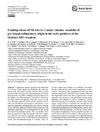Please use this identifier to cite or link to this item:
https://accedacris.ulpgc.es/jspui/handle/10553/46237
| Title: | Floating stones off El Hierro, Canary Islands: Xenoliths of pre-island sedimentary origin in the early products of the October 2011 eruption | Authors: | Troll, V. R. Klügel, A. Longpre, M. A. Burchardt, S. Deegan, F. M. Carracedo, J. C. Wiesmaier, S. Kueppers, U. Dahren, B. Blythe, L. S. Hansteen, T. H. Freda, C. Budd, D. A. Jolis, E. M. Jonsson, E. Meade, F. C. Harris, C. Berg, S. E. Mancini, L. Polacci, M. Pedroza, K. |
UNESCO Clasification: | 250621 Vulcanología | Keywords: | El Hierro Canary Islands |
Issue Date: | 2012 | Publisher: | 1869-9510 | Journal: | Solid Earth | Abstract: | A submarine eruption started off the south coast of El Hierro, Canary Islands, on 10 October 2011 and continues at the time of this writing (February 2012). In the first days of the event, peculiar eruption products were found floating on the sea surface, drifting for long distances from the eruption site. These specimens, which have in the meantime been termed "restingolites" (after the close-by village of La Restinga), appeared as black volcanic "bombs" that exhibit cores of white and porous pumice-like material. Since their brief appearance, the nature and origin of these "floating stones" has been vigorously debated among researchers, with important implications for the interpretation of the hazard potential of the ongoing eruption. The "restingolites" have been proposed to be either (i) juvenile high-silica magma (e.g. rhyolite), (ii) remelted magmatic material (trachyte), (iii) altered volcanic rock, or (iv) reheated hyaloclastites or zeolite from the submarine slopes of El Hierro. Here, we provide evidence that supports yet a different conclusion. We have analysed the textures and compositions of representative "restingolites" and compared the results to previous work on similar rocks found in the Canary Islands. Based on their high-silica content, the lack of igneous trace element signatures, the presence of remnant quartz crystals, jasper fragments and carbonate as well as wollastonite (derived from thermal overprint of carbonate) and their relatively high oxygen isotope values, we conclude that "restingolites" are in fact xenoliths from pre-island sedimentary layers that were picked up and heated by the ascending magma, causing them to partially melt and vesiculate. As they are closely resembling pumice in appearance, but are xenolithic in origin, we refer to these rocks as "xeno-pumice". The El Hierro xeno-pumices hence represent messengers from depth that help us to understand the interaction between ascending magma and crustal lithologies beneath the Canary Islands as well as in similar Atlantic islands that rest on sediment-covered ocean crust (e.g. Cape Verdes, Azores). The occurrence of "restingolites" indicates that crustal recycling is a relevant process in ocean islands, too, but does not herald the arrival of potentially explosive high-silica magma in the active plumbing system beneath El Hierro. | URI: | https://accedacris.ulpgc.es/handle/10553/46237 | ISSN: | 1869-9510 | DOI: | 10.5194/se-3-97-2012 | Source: | Solid Earth [ISSN 1869-9510], v. 3 (1), p. 97-110 |
| Appears in Collections: | Artículos |
SCOPUSTM
Citations
51
checked on Jun 8, 2025
WEB OF SCIENCETM
Citations
35
checked on Jun 8, 2025
Page view(s)
103
checked on Oct 12, 2024
Download(s)
125
checked on Oct 12, 2024
Google ScholarTM
Check
Altmetric
Share
Export metadata
Items in accedaCRIS are protected by copyright, with all rights reserved, unless otherwise indicated.
